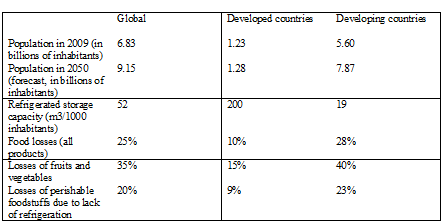Public discussion on the importance of cold chain improvement has increased since the increasing importance of controlling infectious diseases through vaccination across the globe as well as increased demand for trade in perishable products such as dairy and seafood.
Our Master of Global Food and Agricultural Business share their views about this issue.
By Shaibu Mustapha, Yifan Chu, Prateek Patil and Lijun Li
One of the important things in agricultural value chains of developing nations is the need to develop an appropriate cold chain system. Cold chain criteria cover temperature recording and tracking, temperature controlling and commodity inspection. As shown in the table below, about quarter of the perishable food produced in developing countries is lost due to the lack of proper cold supply chain system. The demand for a contiguous refrigerated storage and transport facilities from producers to the consumers has become indispensable in the developing nations.

Cold Chain, Food Security and Economic Development
Source: IIR. 2009. The role of refrigeration in worldwide nutrition (www.iifiir.org)
The importance of cold chain in developing nations’ supply chain is driven by a number of factors. These include increasing distance between production centres and consumers due to urbanisation in developing nations; high demand for quality fruits, vegetables, meat, fish and dairy which are perishables and temperature labile foods due to increased middle class and disposable incomes; rapid ‘supermarketisation’ and changes to export oriented agriculture and high demand for vaccines and veterinary drugs which must be transported over a distance.
In most developing countries, the proportion of agriculture products occupies big part in trade and most of the tradable high-value products have short shelf life.
An inefficient cold chain system and the supporting infrastructure limits developing countries’ ability to meet food safety and quality standards.
Cold chain is vital in reducing food insecurity and poverty in developing nations. Food loss is common in developing nations because of huge post-harvest losses along the value chain. This aggravating food insecurity and poverty situations particularly happens in the least developed nations. Since there is a direct correlation between poverty and food insecurity, if an appropriate cold chain infrastructure is provided, farmers’, processors’ and distributors’ can get access to high value markets because they can meet quality standards and receive high price hence improving their welfare.
Some developing countries are using horticulture as a strategy to diversify their agriculture to improve food security, reduce poverty and expand trade. A good cold chain system will assist horticulture to flourish. For instance, Government of Ghana and African Development Bank co-financed construction of temperature-controlled pack houses, provision of refrigerated trucks and construction of feeder roads to augment cold chain infrastructure for horticultural export. The project was aimed at increasing competitiveness and enhancing integration of horticultural producers into the international market (Read more about the project here).
There are some suggestions on improving cold chain system in the developing countries.
First, cold chain systems are mostly owned and operated by private sector. However, public investments in roads and electric infrastructures by governments can create an enabling environment for cold chain system to thrive. Second, food companies can work with logistic companies and integrate food resource, cold chain resources and social resources. It is suggested that logistics industry associations can jointly establish cold chain logistics distribution centre, and implement the joint distribution of cold chain logistics industry. Third, engagement of the private sector through Public-Private Partnership (PPP) in the provision of appropriate infrastructure, training and, research and development (R&D) should be encouraged.


